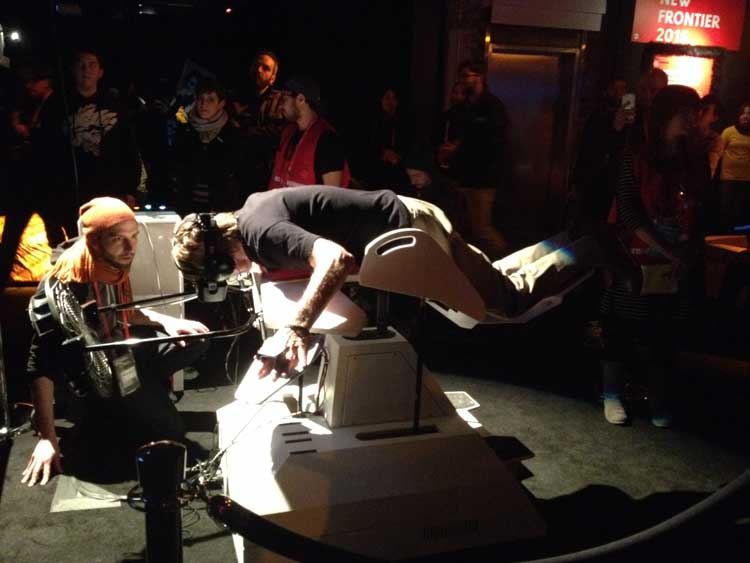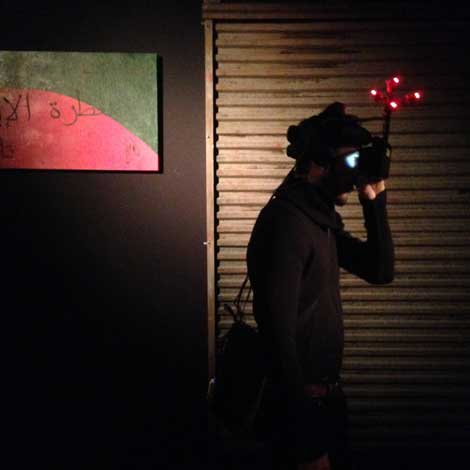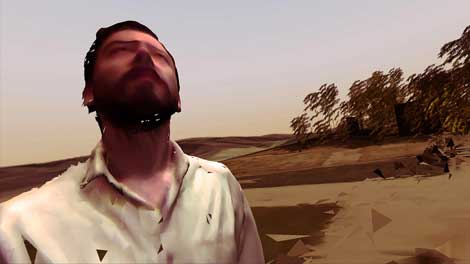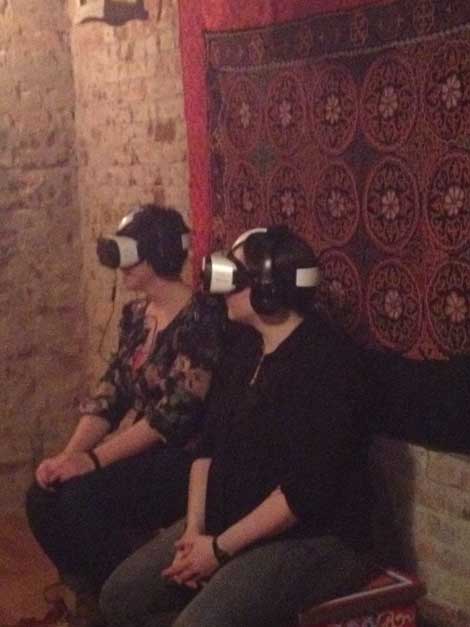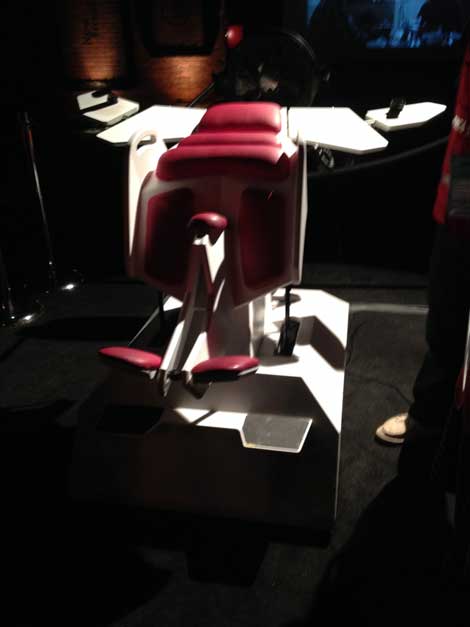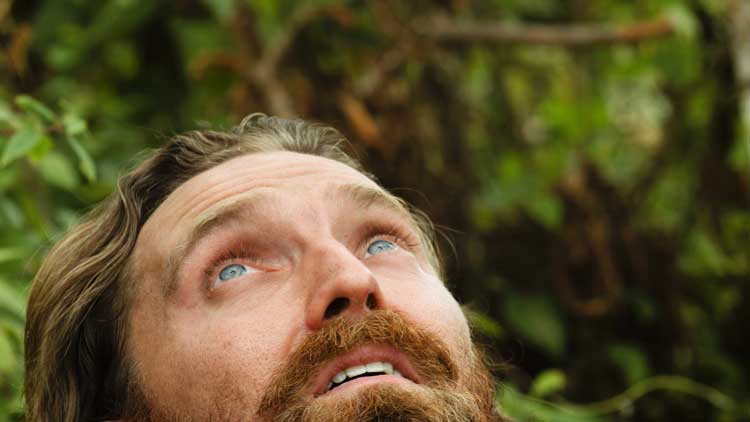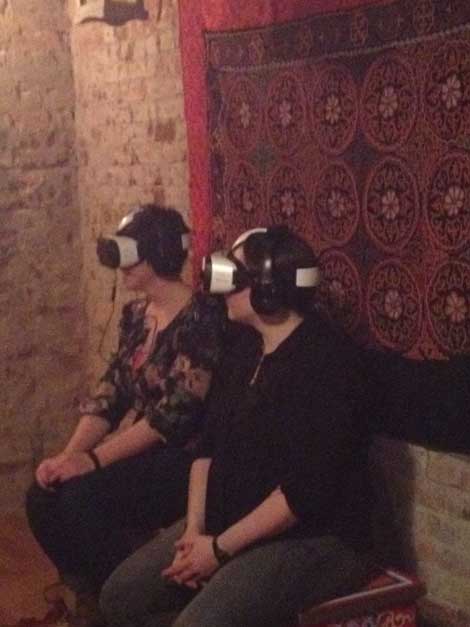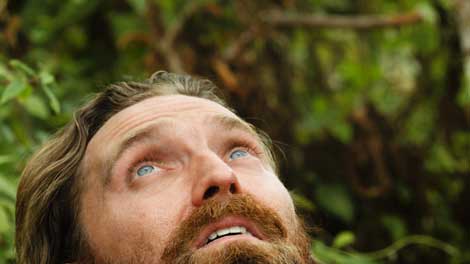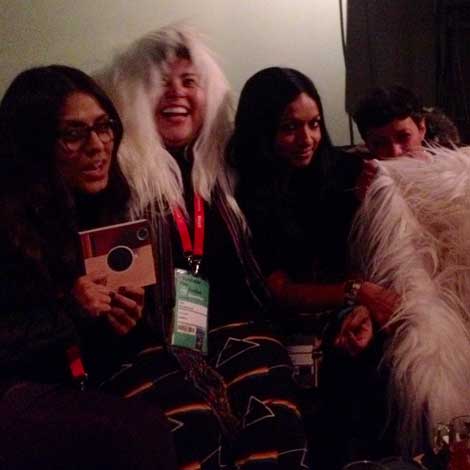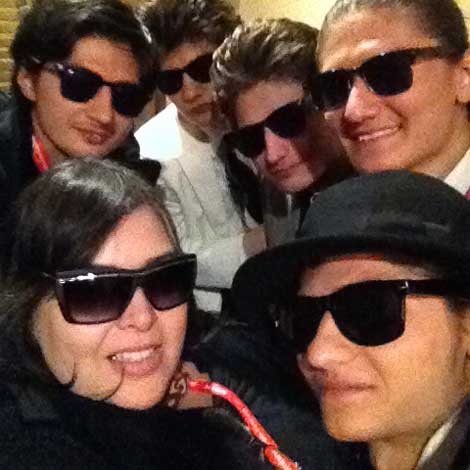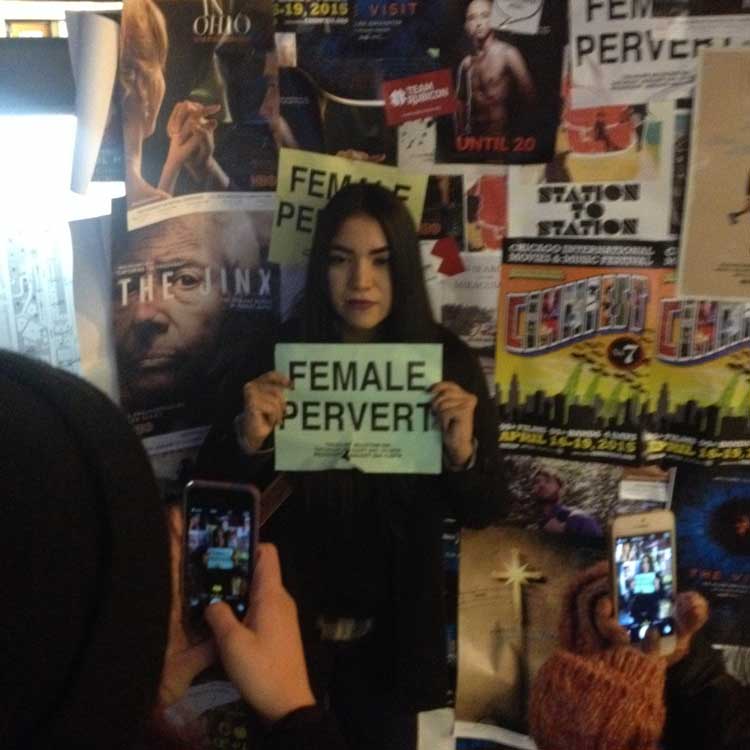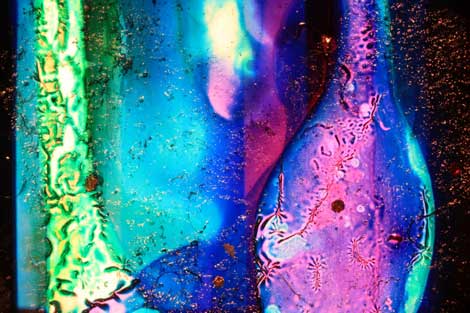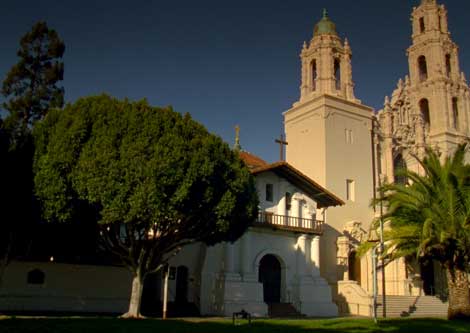Your cart is currently empty!
Byline: Nao Bustamante
-

Sundance: Part 3
Time was running out for me and I had to experience some of the goggle hype at the New Frontier installation space. It’s a kind of expanded cinema meets art, meets doc, meets VR, meets Connect sort of space. A person could really spend three full days experiencing the work on the two floors. It’s brutal to move in and out of Virtual Reality and let’s face it. I’m B.A.L.D. (Born Analog, Learned Digital). My biggest concern was contracting pinkeye and some of the usual challenges existed for organizing audience to experience the work, that seems to be geared eventually for at-home enjoyment, but really isn’t available to the average consumer yet. One crafty take-home device was Google Cardboard, a seemingly conceptual bounce away from Google Glass. When handed to me it was about the size of a personal pizza box. Once opened, simple instructions made for a quick goggle assemblage, with a place for your smartphone and a download site to experience groovy 3D effects. Although some very compelling material was on display I couldn’t help but feel that Chris Milk’s eyes-wide-open baby in the womb beckoning me with its creepily chubby hand was bizarrely pro-life.

experiencing a bombing in Syria 
Assent I quickly left the feel good floor and hightailed it up to the intensely immersive and content driven third floor. There I experienced sexual assault, a bombing in Syria, and the 1979 revolution in Iran. Oscar Raby, with his project “Assent,” accomplished the most adept use of the Oculus Rift technology. This autobiographical immersive documentary put the user inside Raby’s father’s bedroom, which is also the physical space that three viewers are located. Raby, the narrator, is tender as he talks to his father, who in 1973 was a 22-year-old army officer stationed in Chile, on the day when the Caravan of Death came to his regiment. We move to Raby’s studio and eventually to the site of the heinous execution. There was so much dread and tension I was wrung out by the end of it all.

Birdly sans rider I needed a VR vacation. As I approached “Birdly” by Max Rheiner I couldn’t help but think it looked like some perverse upside down gynecological chair. But that’s just me. I threw on my wig and kaftan and was ready to experience soaring sensations. Just then there seemed to be a time shift as Robert Redford himself was touring the exhibition. I tried to not take attention in my messy honey blond wig. But after Bobby’s ride on the big bird, I couldn’t help myself and as he passed I said, “That was hot Bobby.” He smiled and grabbed my hand. Not in a hand-shaking gesture but in as a sign of connection. I was next and couldn’t help but notice the Birdly attendants didn’t sanitize after Bobby, like they had with previous flyers. In fact just prior to Bobby they had cleaned the contraption thoroughly as I was on hand to supervise. I considered mentioning it, but thought I might get an extra thrill contacting Bobby’s DNA. And I did. The flying was basic but amazing. I took myself on some mild dives and swoops. I tried to flirt, bird-style with a passing hawk. I circled and soared for a full five minutes. I can see a future Birdly with a more customizable and form fitting carriage, which also has a tension adjustment so that you could get a full body workout in just 7.3 minutes. I see a virtual amusement park online or joining up with a particular flock of birds. Birdly could be used to help those with a fear of heights, or as a team builder or to gain sensitivity to our environment. When I got off the ride I felt shaky and the back of my neck was tingling hard. I didn’t actually get to interview Shari Frilot, the programmer extraordinaire of New Frontier, but I did have a dream about her. I was trying to pitch her some kind of project and I had a notebook with loose papers taped into the book—she didn’t seem to mind the unruliness. I told her we were going to do something we had never done before. She pulled a piece of paper out of her pocket, on the paper was scrawled in handwriting, “It was 1971 and I was unfamiliar with the medium…” It went on, but that was all I could read. She had a big smile on her face and said, “I’m talking about this!” Apparently it was all about the story.
Nao Bustamante is an artist and educator. She is spending her sabbatical in LA where she will have a solo exhibit at VPAM on May 16th.
For more information: www.naobustamante.com -

Sundance: Part 2
I’m unclear what happened next but I do know after not getting into some parties (BET) and getting into others we ended up at the Celebration of Music in Film, highlighting the festival’s opening night film What Happened, Miss Simone? Performing at the event was Common, Erykah Badu, Aloe Blacc, Kate Davis, Andra Day and Al Schackman, Simone’s long time guitarist/musical director. The only way to describe the event was transporting. As a longtime Nina Simone devotee, hearing her songs deftly interpreted live was awesome: a wholly emotional experience, my hands in the air, tear-stained cheeks. “…Every body knows about Mississippi goddamn!” The flower of love was blooming at Sundance. I got several hugs from strangers, and not the creepy kind. Afterwards, there was nothing to do but bring our ecstatic energy to New Frontier, my home at Sundance. New Frontier is the expanded cinema limb of Sundance, exploding this year with its Ocular Evolution. We had been here before for the opening party, but then it was crowded and there was no way to experience the immersive quality, unless you were dogged, which I am not. But tonight was something different. Was it the Doug Aitkens’ party that I was trying to get invited to? I don’t know, but he was there and his film was playing and then there was this hair metal duo from Chicago, “White Mystery.” And a world class auctioneer, riffing on top of a droning score and Aitkens hugged me, in a pure way. How many parties have you moshed at and also napped at? That’s a good party.

Is this what the future looks like? New Frontier VR The next day or maybe it was the day before led us to the Egyptian Theatre, my favorite movie house in town. One could imagine Tallulah Bankhead in a Q & A there. This particular afternoon was the screening of the digitally remastered Paris is Burning, the intimate portrait of New York’s Latino and black transsexual/transgender community, circa 1989. I was excited for the generous and energetic director, Jennie Livingston. This film was not only remastered, but also returned to its original aspect ratio! I know! John Cooper, the festival director, introduced the film and choked up a bit when he told the story of his first assignment at Sundance. It was 1991 and he had to watch some films at the Angelika Film Center. Paris is Burning was the first film he saw and thought, “Wow, if my job is going to be like this, it’s going to be amazing!” The film went on to share the Jury Grand Prize at Sundance in ’91 and here he was introducing that same film to be archived at UCLA—thanks to the collaboration between the Sundance Institute, the UCLA Film & Television Archive, and the Outfest Legacy Project. Let the good feelings flow. As Pepper says, “We are just a big group of human beings in a mutual bond.”

Things of the Aimless Wanderer This was a film day and we rushed to catch a New Frontier film, Things of the Aimless Wanderer by Kivu Ruhorahoza. This is Kivu’s second feature and his first step into the “Anglo-Saxon” market. This complex film, set in Rwanda, about a romanticizing western (blue-eyed devil) news correspondent and a dispossessed African man is impressionistic with sparse and targeted dialog. A third character, a woman is involved as she gets disappeared several times in the imagination or at the hands of the two men. She is dragged and carried to isolated locations where she will or will not be found—she offs herself a couple of times too. The film employs the Rashomon effect. Maybe the most telling scene was of the two men ostensibly comparing penis sizes in the toilet, or so it was implied. It was a careful but disturbing film, so I asked Kivu to take a moment with me. I felt on the outside of grasping this particularly East African dynamic and he broke it down for me in black and white. The white man romanticizes the black woman with his ridiculous voice over in a British accent, complete with piano music tinkling in the background. (I should mention that when he, the new correspondent speaks, he has an American accent.) The black man infantilizes the woman, unsure how to respond to her newly found sexual freedom and his own perception of a slipping patriarchy. He himself feels irrelevant and society as a whole is going through another fresh round of rejecting western ways. The genocide left many women without brothers, partners and fathers. And for the director, the woman’s character is the most complex. I found her to be voiceless. To drive home the point in one scene she is wrapping tape over her own mouth. This woman has agency at different points in the stories as her role shifts, but the outcome is always the same for her, disappearance. I respect Kivu’s telling of a story I am only beginning to understand. He apologized for his English, saying that he usually conducts interviews in French and then he said, “The stories of women are still being told by men.” He is right.

Party Girls Next we hopped the shuttle to see Entertainment, directed by Rick Alverson and written by the team of Alverson, Gregg Turkington (Neil Hamburger) and Tim Heidecker. This story of a caustic comedian played by Turkington—with a mean comb-over—was a menacing road trip film. The comedian is a loner and the treatment of the women in the film was to keep them at arms length. Even when he has a quite intimate experience with one female stranger we never see them touch. Turkington’s characterization of the comedian was draped over the script. He has this little upturned smile that appears at stressful moments just before sliding into a stoic despair. They really got the forlorn touring elements right. The backstage is always my favorite place, and a lot of stuff happens in the toilets—it was a bit of a bathroom film, especially in the way that bathrooms can be cold and bleak. The cinematic tropes were like familiar sign posts, instructing me to accept the descent. The soundscape was both charming and eerie. It felt like I was on a slow moving emotional roller coaster with blind corners, heading into the mines—if mines had roller coasters. I relished in the base humor of the comedian. He had me at an early joke, “Why don’t rapists eat at T.G.I. Friday’s?” You know those films where you catch yourself with a stupid smile plastered on your face? There were a few good Mexican culture cameos, but I’m not going to tell you what the film is about. See it if you have a dark sense of humor. I spotted Gregg in the bar before the screening and remarked on his style. “A letterman jacket on a middle aged man isn’t a good look,” I confessed this to him post-screening. He said he dressed that way to keep people from talking to him.

Wolfpack…Nao in lower left forefront There was one film that people kept mentioning to me and since I couldn’t get a ticket to Tig, I headed to The Wolfpack. This film tells the story of the Angulo brothers, playfully named the Wolfpack by one of the filmmaker’s friends. The wolfpack were raised in isolation with each other in a lower east side apartment in Manhattan. Imagine a young hippy girl from Wisconsin meets a charismatic Peruvian guide on the Incan trail. They fall in love and decide to go to New York and make money to journey to an intentional community somewhere in the exotic land of Scandinavia. But instead they have kids and home-school them and try to shield them from the dangers that lurk at their doorstep. The brothers develop their own world and their own way of making sense of life and family through the blockbuster movies they watch and reenact. I could tell you every detail of this movie and it still wouldn’t prepare you for the originality and creativity exhibited by the astounding brothers—the gentleness imparted to them by their mother or the fiercely independent men they are becoming. It took a sensitive filmmaker like Crystal Mosselle to bring us this story. It’s an instant classic along the lines of Grey Gardens but with a hopeful ending. I saw Jennie Livingston at the screening. She mused on the future of this film and how it would eventually be in the UCLA archive. I sure hope so. This just in: The Wolfpack won the Grand Jury Prize for a documentary.
Nao Bustamante is an artist and educator. She is spending her sabbatical in LA where she will have a solo exhibit at VPAM on May 16th.
For more information: www.naobustamante.com -

Sundance: From the Inside Looking In
We all know about the parasitic commerciality at Sundance. The festival desperately clinging to their long forgotten outsider status: the overpriced condos, the jello shot luge, the metal business cards and models that have lost their shoes. We’ve all heard the story of a famous actor getting a BJ while watching The Secret on his phone, or discovering “the face” of Perky Jerky at the CAA party. And all of these things may or may not have happened in the peaks surrounding Park City.

Wolfpack…Nao in lower left forefront With all of this, art happens. I was there for seven days, I think—it felt like three. What follows is a telling of time, there, at Sundance 2015. One of the days we saw four movies, that was the most we could see if we were traveling from location to location and also attending receptions and also eating. I saw a lady on twitter that had seen 42 movies. I had wished I were she. There were prevalent FOMO feelings associated with my meager reviews, but I’m going to tell you anyway.

Still from Jennifer Reeves “Color Neutral” The first night I went to a party and then another party and that party was better than the first party. A consumerist with abundance issues can really get caught up chasing free booze and headphones and so the second night, I was determined to see a movie. My first film of Sundance 2015 was actually a film. I think the only film projected at the festival. It was Jennifer Reeves’ 16 mm film, Color Neutral. It was a quick leap mentally from, I’m glad someone is still doing this-kind-of-work (a la Brakhage) to I’m going to sink in and enjoy the stratifying color push, the bubbles and cracks. I kept thinking that the black drapes on either side were slowly opening and that the film was swallowing me up. I was in the second row and I fell into the film. Just like that, I was swimming in the beautiful abstraction of hand-processing.

Still from The Royal Road Then came Jenni Olson’s, The Royal Road. Also shot on 16mm, it was a mash-up of quiet landscapes, mostly from San Francisco—my San Francisco. Los Angeles—my Los Angeles—and parts along the El Camino Real, also a touchstone from childhood. Olson’s quivering butch tale of exquisite girl torture was somehow transposed along side a thin tale of Father Juniper Serra, an 18th-century Spanish Franciscan friar who was responsible for much horror in his time on behalf of Spain in what is known today as, California (and now he’s gonna be a saint?). This film without figures, save the occasional person walking in the distance or glimpsed in a car, served up strategically unremarkable frames to view the world. I say unremarkable, because there were no extreme angles, precious foregrounds, or visible signs of art-direction in the shots. The shots were simple, the act of watching was seeking beyond the frame, squinting and searching for what I’m looking at. There was, simultaneously a calculated vulnerability in the diary entry style narration performed in the gravely, wobbly-kneed voice of Olson, which ended up narrating the rest of the evening in my head and followed me throughout Sundance. Later I ran into the actual Olson at the press office and in her typical way she spoke of her film as the “little thing nobody cares about.” She joked about her market rep trying to sell her very uncommercial film and the kind of privilege that comes with not caring. Hopelessness is a kind of freedom, isn’t it? It can be a political stance, when work isn’t specifically shaped for the market, even a sophisticated market. “Where are our public intellectuals?” Olson railed. We spoke of Jennie Livingston’s new film essay, Earth Camp 1 and about the groundbreaking late Marlon Rigg’s Tongues Untied. Olson rose again, “Why would we not push the capacity of cinema? The mainstream lacks confidence.” And then we quickly worked out “The Royal Road” series pitch for HBO.
Nao Bustamante is an artist and educator. She is spending her sabbatical in LA where she will have a solo exhibit at VPAM on May 16th.
For more information: www.naobustamante.com
